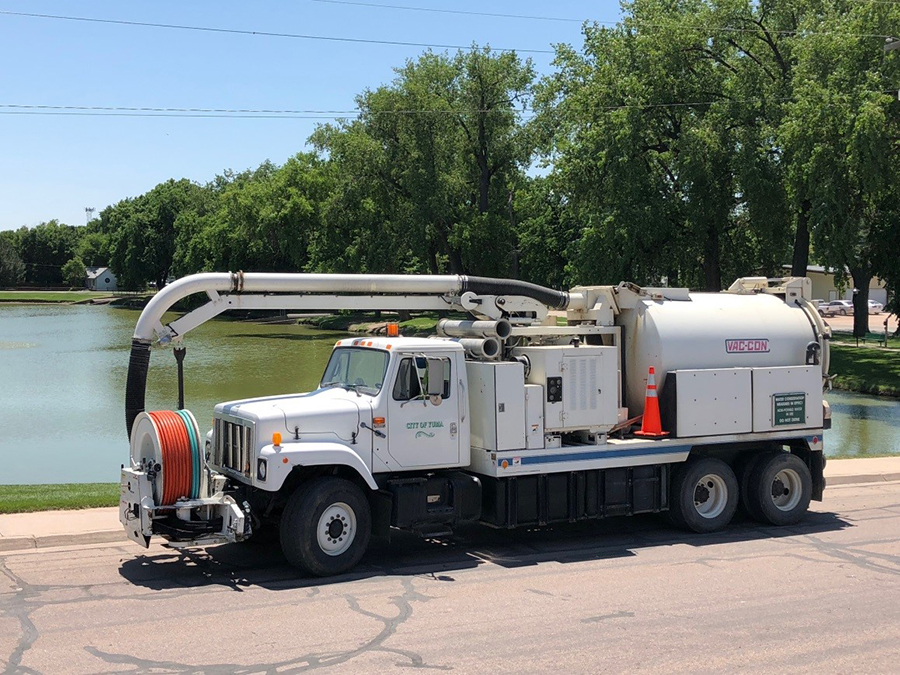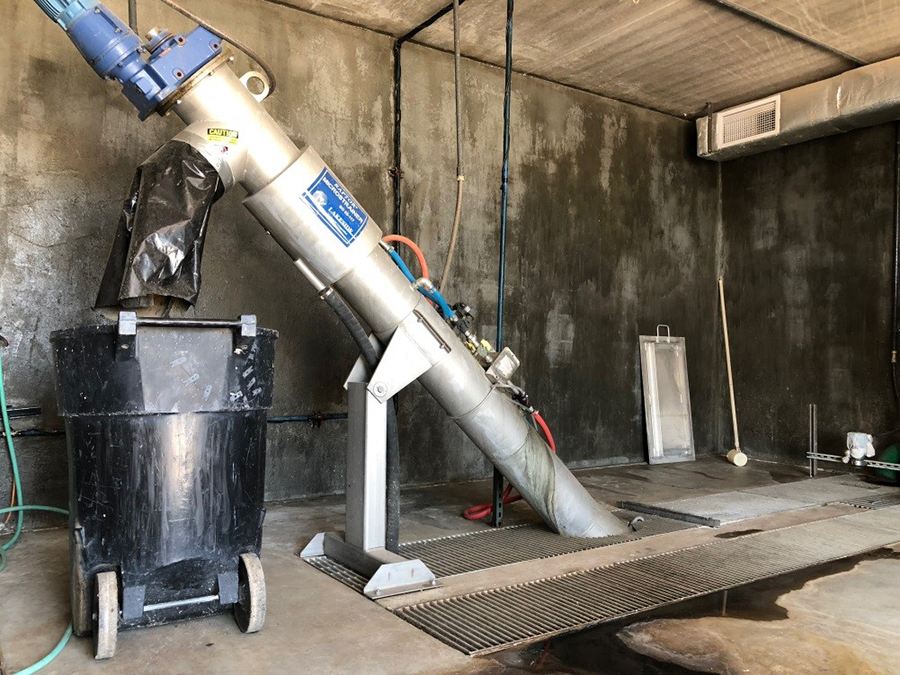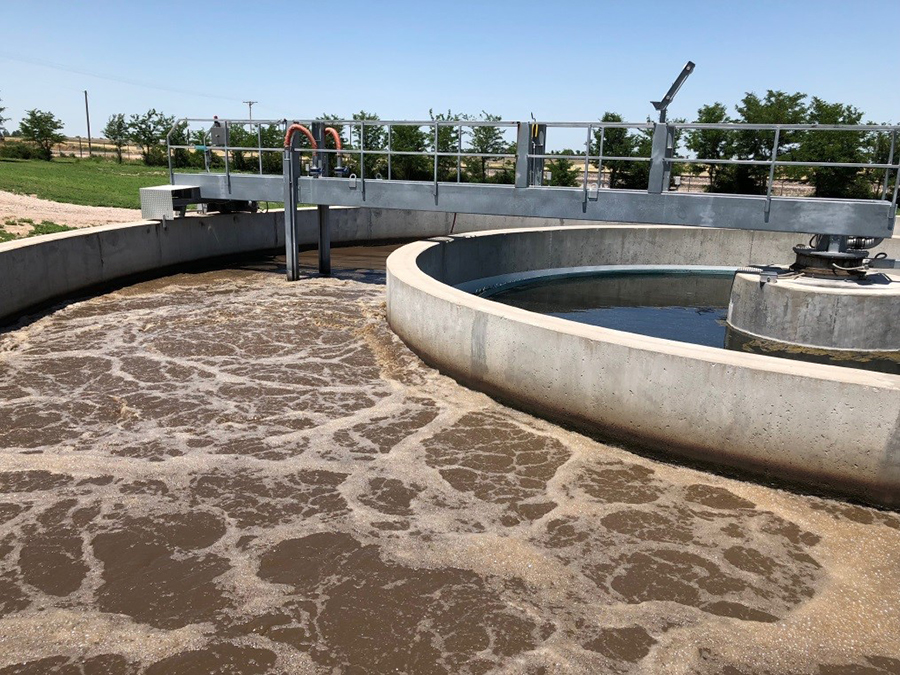Wastewater
Collection System
The City of Yuma maintains 2 square miles of clay tile and PVC pipe that make up the wastewater collection system.
The vast majority of our collection system is 8 inch pipe, but includes pipe sizes ranging from 4 inches to 24 inches in diameter. These collection lines, along with four strategically placed lift stations in low lying areas, facilitate the transport of wastewater to the Wastewater Treatment Plant.
Maintenance and Cleaning
Each year, staff cleans one half of the collection system and each end line, using a jet/vacuum truck. Throughout the year, operators also respond to trouble calls, employing the use of a camera to inspect lines, and the jet truck to clean lines as needed. Wastewater operators also visit each lift station twice a week to ensure that the pumps and controls are clean and working properly. The City of Yuma is also diligent in repairing and replacing our aged infrastructure.
Collection System Challenges
The City of Yuma takes every chance it can to educate the public about problems associated with sewer lines, and what our customers can do to help. Many of the difficulties in wastewater collection and treatment are directly related to fats, oils, and grease (known in our industry as "FOG") that is put into the wastewater collection system. FOGcan contribute to back-ups in sewer lines, and is hard on equipment such as pumps and floats throughout our system.
Wastewater Treatment Plant (WWTP)
The City of Yuma owns and operates a Schreiber Extended Aeration mechanical treatment plant. The WWTP, which was built in 2005, treats approximately 300,000 gallons of wastewater every day, using a process known as Activated Sludge. Our plant uses this fascinating and effective method to recover and clean our nation’s most precious natural resource – water!
Wastewater Influent
When wastewater arrives at the WWTP, it enters an influent lift station, and is immediately pumped into our headworks building. Influent samples are collected and important tests are performed, which helps determine the effectiveness of our process. These tests include such things as TSS (total suspended solids) and BOD (biochemical oxygen demand).
Domestic wastewater is typically 99.9% water, but does contain trash and debris that must be removed. This process is known as preliminary treatment.
Preliminary Treatment
In the preliminary treatment phase, mechanical equipment is used to separate trash from the wastewater. This trash is what you might imagine it being: rags, paper products, flushable wipes, kids toys, etc. The trash is removed from the influent, de-watered, and hauled to the landfill.
Next, the wastewater moves through a channel and into the grit removal system. Grit is defined as settleable solids such as sand, rocks, coffee grounds, eggshells, and chicken bones. The flow is slowed, allowing the solids to settle into a grit chamber, where they are removed. Like the trash removed in the first step, the grit is de-watered, and hauled to the landfill.
Areation Basins, Clarifiers, and Activated Sludge
After preliminary treatment, the water flows into a splitter box, where it is distributed evenly into two 357,000 gallon aeration basins. In these basins air is added to the water using diffusers attached to rotating bridges that continuously run around the basins. The air is controlled by timers and set points that keep the concentration of dissolved oxygen (D.O.) in the desired range. The purpose of the air is, in simple terms, to help us grow “bugs”, and in more complex terms, to consume BOD, and initiate the nitrification/denitrification process in which ammonia is oxidized and converted to nitrites, nitrates, and nitrogen gas.
The bugs that are grown are the stars of the WWTP. These bugs are known as activated sludge, and can basically be described as the microorganisms that clean our wastewater. Operators closely watch the microbes that are living in our plant, because the bugs we see indicate the type of environment that exists in our process. Typical wastewater microbes that we look for include stalked ciliates, free swimming ciliates, rotifers, water bears, and even more complex organisms such as bristle worms and nematodes. The influent that flows into the aeration basins contains food for these bugs. The bugs eat and grow in the aeration basin, before they are transferred into one of two 134,000 gallon clarifiers.
In the clarifiers, the bugs no longer have air or food. In essence, they are starved during this phase. This causes the bugs to settle to the bottom of the clarifier tank, taking the settable solids with them, and leaving clean water on the top. This water flows over weir plates and out towards tertiary treatment and the effluent line. In the clarifiers, operators work to remove algae growth, and keep the weirs clean as the effluent water overflows.

The jet/vacuum truck is an extremely important machine for the Wastewater Department

The Raptor Micro-strainer is used to collect and de-water rags and other trash from the raw influent.

Aeration basins are where the activated sludge is given oxygen and food. To the right, water on the surface of the clarifier slowly flows over the weirs to the effluent

Aerators add dissolved oxygen to the aerobic digester.

The final effluent at Yuma WWTP is clean and ready to be returned to the ground.

The MCC room houses all of the plants electrical components, including VFDs for the influent pumps and soft starts for the blower motors
Return Activated Sludge and Waste Activated Sludge
RAS and WAS are acronyms that refer to activated sludge in different phases of the process. RAS, or Return Activated Sludge, refers to the bugs that have settled out of the clarifiers, and are ready to return to the aeration tank where they will be fed again. The life cycle of a microorganism is important to understand for wastewater treatment. Organisms that are too young or too old are simply not as effective at cleaning our water and properly settling out. Therefore, each day a certain amount of RAS becomes WAS, or Waste Activated Sludge. The amount of WAS is based on a calculation of solids concentration and the desired sludge age. The appropriate amount of WAS is pumped to our aerobic digester, for another important step in the process.
Aerobic Digestion
The final stages of a microorganisms‚ life is known as endogenous respiration. In this phase, organisms start to oxidize some of their own cellular mass, instead of new organic matter. In the aerobic digestion process, air is added, to facilitate the aerobic bacteria, as the microorganisms eat themselves and each other. This step helps us achieve the goal of solids reduction.
Periodically, the air is turned off, and settling occurs once again. We take the clear water on the top (known as supernatant), and decant it back through our process. Meanwhile, the organic material that settles to the bottom is transferred to drying beds, where it is de-watered, and becomes a new and useful product known as biosolids.
Disinfection and Effluent
The water that flows over the weirs in the clarifier heads to a Parshall flume where the flow is measured, and it is disinfected with a dose of sodium hypochlorite (chlorine). The chlorine inactivates and destroys any living organism that is in the wastewater. After an appropriate amount of contact time, the chlorine demand is met, and the water is clean and ready to be discharged. Samples are taken of the effluent water, and many important tests are performed once again, including TSS and BOD.
Our effluent is discharged into four IP (infiltration percolation) ponds, where the water is returned into the ground water, or evaporated back into the hydrologic cycle. The water that we discharge must meet standards laid out by the regulatory arms of the CDPHE and EPA. Those specific terms are tracked and reported in our Discharge Monitoring Report, which is filed to the State of Colorado monthly.
Disinfection and Effluent
The water that flows over the weirs in the clarifier heads to a Parshall flume where the flow is measured, and it is disinfected with a dose of sodium hypochlorite (chlorine). The chlorine inactivates and destroys any living organism that is in the wastewater. After an appropriate amount of contact time, the chlorine demand is met, and the water is clean and ready to be discharged. Samples are taken of the effluent water, and many important tests are performed once again, including TSS and BOD.
Our effluent is discharged into four IP (infiltration percolation) ponds, where the water is returned into the ground water, or evaporated back into the hydrologic cycle. The water that we discharge must meet standards laid out by the regulatory arms of the CDPHE and EPA. Those specific terms are tracked and reported in our Discharge Monitoring Report, which is filed to the State of Colorado monthly.
Process Control and Maintenance
Throughout the week, operators perform process control tests to evaluate the functions of the plant. Samples are taken throughout the process and are tested for pH, DO, and temperature, as well as solids concentration, and settleability. These variables are recorded and evaluated as a means to determine if changes should be made to the process.
During our daily checks, plant operators also monitor the microbe population, calibrate lab equipment, and perform preventative maintenance checks on equipment such as blowers, pumps, grit and rag screens, and generators.
